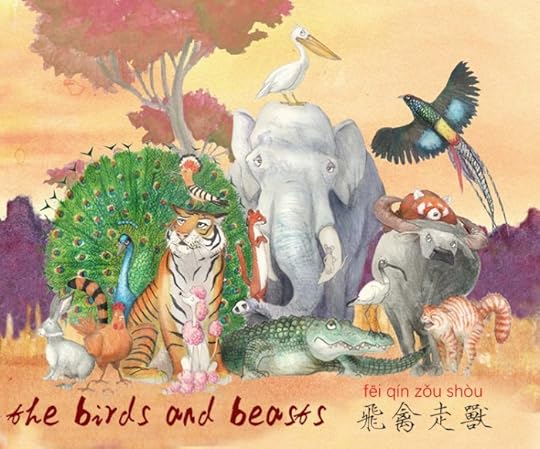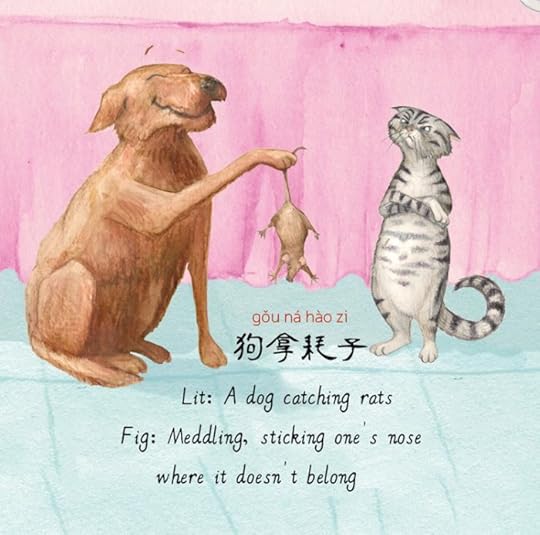Jason Pym's Blog, page 2
March 30, 2020
When I see food…
 (I’m on a seafood diet. When I see food…
(I’m on a seafood diet. When I see food… I’ll get me coat.)
This is an image to be used on the place settings of Houhai seafood restaurant. Below is an explanation of my process when I’m working on a commission…
So these place settings are on A3 paper, the idea is that they serve two purposes: To tell the customers the time that each type of seafood should be cooked (this is a self-cook hot pot restaurant), and secondly they can be thrown out after each customer, making clean up easier.
 They’re using plain white A4 paper at the moment
They’re using plain white A4 paper at the momentSo my first idea is that the different seafood items could be laid out in a kind of clock:
 So you have ‘raw’ at the top (for oysters) then clockwise ‘1 minute’ for shrimp through to ‘3 minutes’ for octopus. The two characters in the middle are ‘Houhai’, the name of the restaurant.
So you have ‘raw’ at the top (for oysters) then clockwise ‘1 minute’ for shrimp through to ‘3 minutes’ for octopus. The two characters in the middle are ‘Houhai’, the name of the restaurant.This was done with a series of pencil sketches:
 Filefish (‘horse faced fish’ in Chinese) and cuttlefish
Filefish (‘horse faced fish’ in Chinese) and cuttlefish Bombay duck fish (not from Bombay, and not a duck, one of those British Empire names) and red tilefish
Bombay duck fish (not from Bombay, and not a duck, one of those British Empire names) and red tilefishBut this sketch had two problems: Cooking the seafood isn’t such an exact science, and the images of the fish were too static, they wanted something more anthropomorphic. So I came up with these:
 For bombay duck (the ‘tofu fish’ in Chinese) and abalone
For bombay duck (the ‘tofu fish’ in Chinese) and abalone The filefish and red tilefish, redrawn.
The filefish and red tilefish, redrawn. Octopus
OctopusDefinitely more interesting. And then put them together in this colour sketch in Photoshop:

So the client was very happy with this, and I went ahead with the final image. I painted all the fish individually in watercolour:
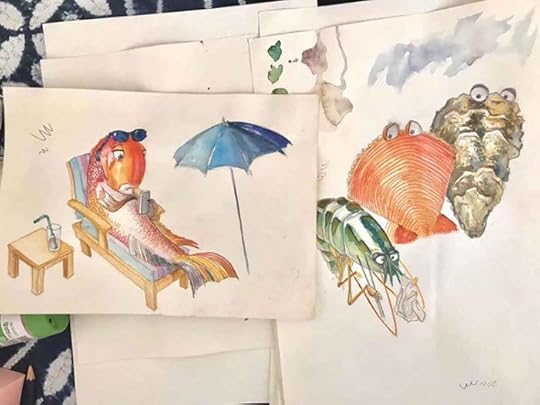 Red tilefish, shrimp, shellfish, oyster
Red tilefish, shrimp, shellfish, oysterAnd put them together in Photoshop:
 The Chinese text is cooking instructions for the hotpot
The Chinese text is cooking instructions for the hotpotI made the whole image much darker, I like the evening look and it let me draw more dramatic shadows giving the image a much stronger ‘3d’ feel, the fish popping out away from the table. But the client wasn’t happy, they liked the light sunshine feel of that original sketch – and with good reason. The restaurant is in Chongqing, a city continuously shrouded in low cloud and smog, the sun (famously) never shines. So the image should get away from all that, and welcome the customer by being light, breezy, uplifting with bright sunshine. Not dark and claustrophobic.
I rejigged the colours back to the colour sketch, and that’s how I came to the final, accepted version:

Which I like, and I’m happy with, but the way the fish don’t stand out so well from the crowded table of food does bother me still :) I couldn’t come up with a good solution for that.
Oi, mind your own…
 Editorial cartoon for an article about China pinching other countries tech
Editorial cartoon for an article about China pinching other countries techI’ve started illustrating cartoons for Export Compliance Manager magazine. The above was my image for the first issue.

For the same issue I also drew the following, but it wasn’t used in the end:
 (Really happy with how the waves turned out)
(Really happy with how the waves turned out)They said it was because the subject was a little too grim, the mask on the boat a bit too threatening. But looking at it now I think it’s because I misspelled Covid as Corvid (doh!), which would be a massive shipment of crows….
For issue two of the magazine, I illustrated an article about the ‘Week in the life of a University Export Office,’ I sent them two images – I like this one:

But the following is the one they picked… The two figures are caricatures of the people working in the export department:

March 29, 2020
January 9, 2020
October 26, 2019
Star Wars wedding
My sister is getting married next month, and (one of) the themes is Star Wars, so I drew these pictures for her – they’re going to be table centre pieces.
 The Millenium Falcon 千年隼 qiān nián sǔn
The Millenium Falcon 千年隼 qiān nián sǔn The Citadel Tower on Scarif, location of the Death Star plans. Plus AT-AT in deely boppers.
The Citadel Tower on Scarif, location of the Death Star plans. Plus AT-AT in deely boppers.死星計畫正在斯卡裡夫行星的城堡塔舉行,外面有頭戴心形裝飾的帝國戰馬AT-AT徘徊著。
 Princess Leia’s rebel blockade runner Tantive IV. And balloons.
Princess Leia’s rebel blockade runner Tantive IV. And balloons.婭公主所在的反抗軍封鎖穿越者飛船坦特維四號。拴著氣球。
 The Rebel Base on Yavin IV
The Rebel Base on Yavin IV亞汶四號衛星的反抗軍基地(在原住民的廢棄神殿內)。
 Yoda looking dapper on Dagobah
Yoda looking dapper on Dagobah 在達戈巴沼澤行星尤達大師敬酒
 Alderaan (Princess Leia’s homeworld). On the back of the Y-wing is a Double Happiness symbol.
Alderaan (Princess Leia’s homeworld). On the back of the Y-wing is a Double Happiness symbol.萊婭公主的家鄉奧德朗行星,Y翼星際戰鬥機背上有個“雙喜”字。
 Outside Maz Kanata’s castle on Takodana, BB-8 holds a wedding bouquet.
Outside Maz Kanata’s castle on Takodana, BB-8 holds a wedding bouquet. 在塔科達納行星上的瑪茲·卡納塔古老城堡外,機器人BB-8持著一朵婚禮捧花。
August 20, 2019
A day teaching art

I love teaching art, but it’s especially nice when you’re in the middle of a botanical garden (云山花海), shaded from the bright summer sun under the shade of trees. A lovely day. Thank you to Ning Jing (宁婧) who organised it all, great to see her son James again too.








Signing books
The Dali Sketchbook is still selling steadily, which I’m very happy about.
Two years ago I was still writing a few careful sentences of thank yous and best wishes in my finest handwriting, but I noticed today after signing thousands of books that I now just put down a messy scribble. This gave me a strange glow of accomplishment, the signed books look just like the jagged scrawl of a proper author.
July 20, 2019
Licking aphids
When out walking the dogs I passed a giant
bamboo, and there was a deafening buzzing sound coming from it. I got closer,
and the leaves of the thing were covered in bumblebees, honey bees, ants, all
sorts in a furious cloud.
Which is odd. Aren’t bees just supposed to
go for nectar? Is the bamboo putting out some kind of sweet sap or something?
So I asked my sister, a lady with a chainsaw trained to know about these things, and she said it’s quite normal, they’re just hanging out licking aphids.
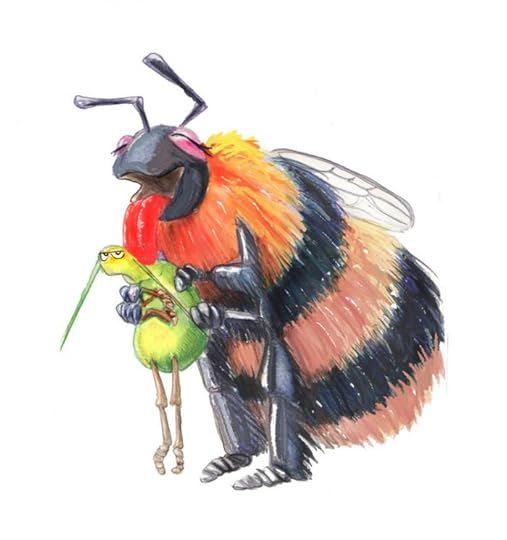 Mmm, aphids.
Mmm, aphids.So I went back and she was dead right – tiny little white aphids covered all the bamboo leaves.
 The aphid character “蚜” uses tooth “牙” as a phonetic, both are second (rising) tone
The aphid character “蚜” uses tooth “牙” as a phonetic, both are second (rising) toneWhy would you want to lick an aphid?
For the sugar, it turns out.
I remember something about ants ‘farming’
aphids like dairy cows, ‘milking’ the honeydew aphids produce as food. Some
ants even nurture ‘herds’ of aphids, and others take aphids’ eggs into their
nest over the winter.
Well, the bees and other insects on this plant are doing the same thing, eating aphids’ honeydew, but are being more opportunistic. The bees use honeydew just as they use nectar: As sugar-water that they can turn into honey, which is then stored in the hive to be eaten later. The bees lick the honeydew off the aphids, or more commonly from the copious amounts the aphids drop onto the leaves.
 Literally ‘cotton aphid’ (cotton = 棉花 mián hua)
Literally ‘cotton aphid’ (cotton = 棉花 mián hua)English names: Woolly aphid (other species are known as greenfly and blackfly, aphids’ colours vary greatly)
Chinese name: 綿蚜 mián yá
Family: Aphididae (蚜科yá kē, the aphid family)
Subfamily: Eriosomatinae
For farmers and gardeners, aphids are a terrible destructive force! They feed by sucking the sap of plants, weakening them, and the honeydew they produce (a sugar-rich sticky, clear liquid) sticks to the plant and spreads fungi (a sooty mould that gardeners loathe).
They don’t lay eggs. Flightless females give birth to a host of other flightless females without males involvement (they’re clones), then they start colonising the plant. Later in the season she gives birth to winged females that can head off to start new colonies on other plants. Males do mate with females in autumn, which leads to a batch of eggs which is how aphids live through the winter.
 Where we are in Yunnan I haven’t seen the typical yellow and black striped ones
Where we are in Yunnan I haven’t seen the typical yellow and black striped onesEnglish names: Bumblebee*
The English name ‘bumblebee’ first appears in the Middle Ages, referring to the way the bees bumble around in a clumsy, awkward way.
Chinese name: 熊蜂 xióng fēng (‘bear’ bee, for its fat, furry appearance)
Family: Apidae (蜂科fēng kē, the bee family, mainly bumblebees and honeybees)
Genus: Bombus (‘booming, buzzing, humming,’ 熊蜂属xióng fēng shǔ)
Latin name: Bombus schrencki (orange back white bum), Bombus muscorum (orange back pale yellow abdomen) **
They live in small colonies of a few hundred at most. They have short tongues (proboscis), and so generally pollinate open (shallow) flowers. The thick fur is insulation, bumblebees are much better at living in colder climates than other bees. Bumblebees can warm themselves up by intensely vibrating, and in cold weather have to do this before they can fly.
Although bumblebees do not have the elaborate ‘honey dances’ of honeybees, they are known to ‘excitedly run around in the nest for several minutes’ after they find a good source of food, tipping off their coworkers.
In spring the queen emerges from her winter sleep, finds a suitable hole for her colony and starts laying eggs. Unlike the neat, hexagonal combs of honeybees, bumblebees make little ‘cups’, the queen lays up to 15 eggs in each.
These eggs turn into female workers, who then collect nectar and pollen and bring it back to the nest. Most bumblebees are female – a colony is the queen and all her daughters doing the work. Near the end of the summer she’ll lay a batch of eggs that turn into males, but their sole job is to go off an mate with a new queen. Then die. Most of the males don’t even get to do their one job in life. This new queen with her now fertilised eggs goes to find a place to sleep through the winter, and the old nest and old queen all die off.
Bumblebees are not aggressive, only the females can sting and will only do so if cornered.
Both bumblebees and honeybees have hind
legs that have evolved into ‘pollen baskets,’ (the scientific name corbicula
(plural corbiculae) is Latin diminutive for basket) with long hairs that trap
and transport pollen – bee larva are fed nectar for carbohydrates, but they
also need pollen for protein.

English names: Asiatic honeybee
Chinese name: 蜜蜂 mì fēng (same as English, honey 蜜 + bee蜂)
Family: Apidae (蜂科fēng kē, the bee family, mainly bumblebees and honeybees)
Genus: Apis (the honeybee, Apis is Latin for “bee”)
Latin name: Apis cerana
Honeybee hives have around 50,000 bees. They famously have the bee waggle dance to tell their comrades where food sources are located.
Male drones can sting you but will die after doing so, so they don’t do it lightly.
* To be pedantic, it should be ‘bumble bee’ and ‘honey bee’ (separated by a space) not ‘bumblebee’ and ‘honeybee’, because they are both types of bees. It’s proper to write ‘butterfly’ and ‘dragonfly’ as one word as they’re not flies – but as bumblebee and honeybee are much more commonly used I went with that.
** Of the two species of bumblebees I’ve seen, both kind of match, and they’re definitely in China, but… If I’ve got it wrong and you know the species please let me know.
July 18, 2019
Aoguang, Dragon King of the Eastern Ocean

In Chinese cosmology, heaven is ruled by the Jade Emperor (玉帝 yù dì), the underworld by Yama, King of Hell (閻王 yán wáng), and the oceans by the Dragon Kings.
In Journey to the West, Monkey visits Aoguang, Dragon King of the Eastern Ocean (東海龍王敖廣 dōng hǎi lóng wáng áo guǎng) who lives in a Crystal Palace (水晶宫 shuǐ jīng gōng) at the bottom of the sea. Monkey takes the Dragon King’s treasure, the Pillar that Holds Fast the Sea (定海神針 dìng hǎi shén zhēn, originally a stick for measuring the depth of sea water used by Yu the Great, controller of floods). The Pillar became Monkey’s famed weapon, the Golden-banded Staff (如意金箍棒 rú yì jīn gū bàng) that shrinks the size of a sewing needle and fits behind Monkey’s ear when he is not fighting.
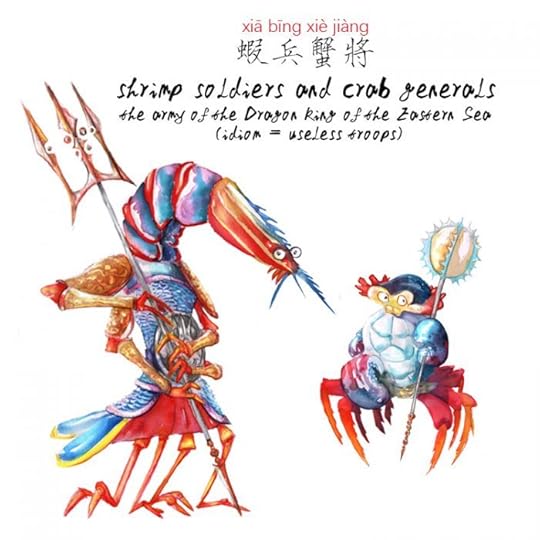
I’m very fond of the Dragon King’s ineffectual army of shrimp soldiers and crab generals, which is used in modern Chinese as an idiom meaning ‘useless troops’.

July 12, 2019
Ladybirds and harlequins
 Ladle bug.
Ladle bug.English names: The seven spot ladybug (America), the seven spot ladybird (other English speaking countries)*
Chinese name: 七星瓢蟲qī xīng piáo chóng (Lit: ‘seven star ladle bug’, ladle 瓢 because of the shape)
Family: Coccinellidae (瓢蟲科piáo chóng kē, the ladybird family)
Genus: Coccinella (‘scarlet’,瓢蟲屬piáo chóng shǔ)*
Latin name: Coccinella septempunctata (septem = ‘seven’ and punctus = ‘spot’)
The ladybird eats aphids and other insects that can damage plants, and so is a favourite with farmers and gardeners.
Living in rural China, many bugs are surprisingly familiar, like the seven spot ladybird. However they also have these massive (2-3 times the size) variously patterned monster ladybirds, called harlequins in English and the boring ‘variegated’ ladybird in Chinese.
 Variegated.
Variegated.English names: Harlequin ladybird, Asian ladybeetle, Halloween ladybeetle (America only)
Chinese name: 異色瓢蟲 (异虫) yì sè piáo chóng
Family: Coccinellidae (瓢蟲科piáo chóng kē, the ladybird family)
Genus: Coccinella (‘scarlet’,瓢虫屬piáo chóng shǔ)*
Latin name: Harmonia axyridis
It has one of the most varied appearances of any species in the world, appearing in all kinds of colour and pattern combinations. And apart from the colours, the other way to tell it apart from the regular seven spot ladybird is that the harlequin is at least twice the size.
Native to Asia, it’s an invasive species in Europe and North America, having a terrible effect on other ladybird species, not least because it eats their eggs and larva.
I later found out harlequin ladybirds are now common in the UK, having been introduced 15 odd years ago, but that was after I left.
The harlequin is named for the chequered-costumed jester of late Medieval Italy.
 小丑 = clown, 哈利昆 is just a transliteration.
小丑 = clown, 哈利昆 is just a transliteration.Both species of ladybird protect themselves by playing dead, and can secrete a foul liquid from their legs which makes them taste unappealing, you may see this if they get stressed out when you handle them. Or try to eat them.
* Entomologists prefer the name lady beetles as though they’re insects they are not ‘true bugs’. A true bug is one that belongs to the Hemiptera order of insects, all of whom share similar ‘sucking mouthparts’: This includes aphids, cicadas, bed bugs, and shield bugs, so really not that many families.

